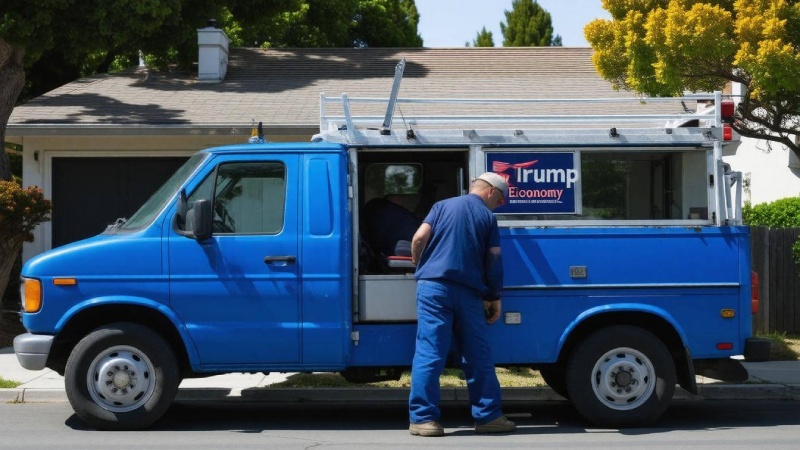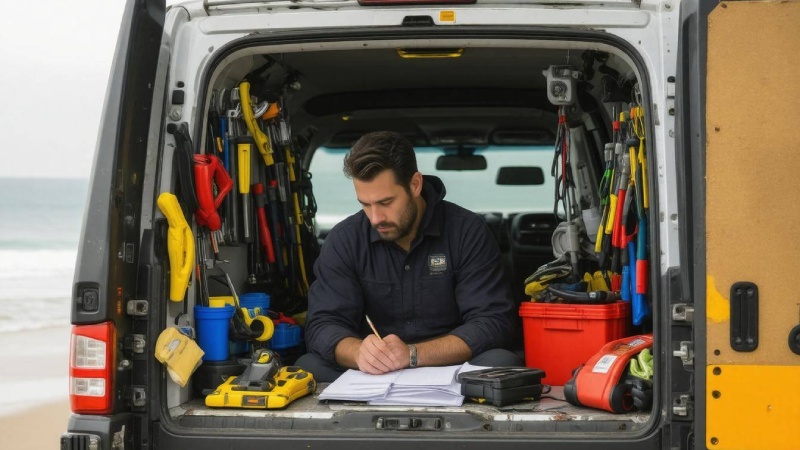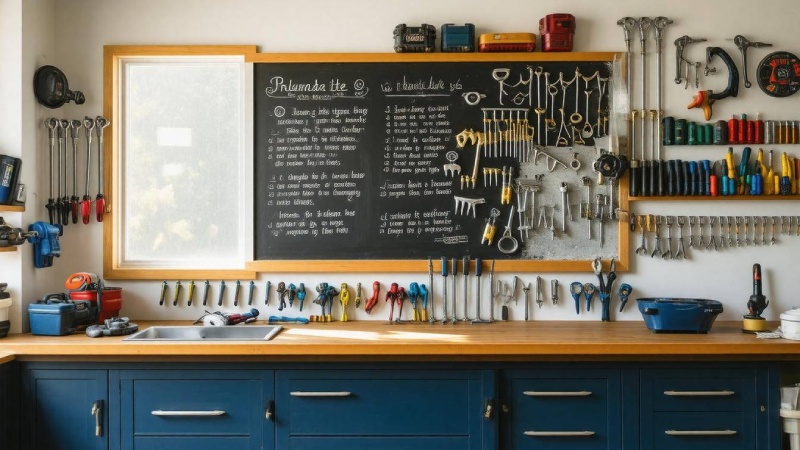The plumbing industry in Santa Cruz may not be the first thing that comes to mind when discussing the economy, but it plays a vital role in our local community and infrastructure. Think about it: every time you turn on a faucet or flush a toilet, you’re relying on skilled plumbers who ensure these essential systems work smoothly. This article explores how recent economic changes, particularly those stemming from the Trump era, have impacted this critical trade. We’ll look at challenges like labor shortages and rising material costs, while also shining a light on opportunities for growth linked to new housing developments and infrastructure investment. Whether you’re a homeowner needing plumbing repairs or simply curious about how these dynamics affect your daily life, understanding the state of this industry can provide valuable insight into the health of our local economy.
The plumbing industry in Santa Cruz has faced challenges such as labor shortages due to stricter immigration policies, rising material costs from proposed tariffs, and opportunities for growth linked to infrastructure investments. These factors collectively influence service pricing, contractor profitability, and overall demand within the local plumbing market according to top Santa Cruz plumber Anytime Plumbing.

Current Economic Climate
The plumbing industry in Santa Cruz, while often regarded as foundational, has felt the reverberations of broader economic shifts instigated by the Trump administration’s policies.
For starters, the reduction in the corporate tax rate from 35% to 21% was initially celebrated by many businesses, giving them more capital to invest in growth and development. This has allowed local plumbing companies not only to upgrade their tools but also to invest in training for employees and attracting new talent. Industry players like Anytime Plumbing Inc have voiced how such financial relief helps them remain competitive amid rising costs.
Yet, while there were undeniably positive aspects, the installation of tariffs on imported metals has cast a shadow over these gains. According to U.S. Census Bureau data, material costs are projected to have risen by approximately 25%. This inflation generally affects raw materials crucial to plumbing projects—think pipes and fixtures—meaning local contractors must either absorb these expenses or pass them onto consumers. It’s a delicate balance that can sway customer satisfaction and affect profit margins.
Coupled with these price hikes is a marked increase in demand for plumbing services. Since 2020, there has been a notable 15% growth in service requests, attributed primarily to aging infrastructure and increased housing developments within Santa Cruz County. Homeowners are waking up to the reality that many homes built between 1950 and 1970 require modern repair techniques due to outdated plumbing systems using inadequate materials that may now be at risk of failure.
As these older plumbing methods fail, they present an urgent need for plumbers with modern skills, further complicating labor dynamics. For instance, plumbers in Santa Cruz are currently earning an average wage of $70,000 per year, experiencing a 10% increase since 2020. Yet labor shortages persist in light of stricter immigration policies. The consequences are two-fold: though wages rise, fewer skilled workers are available to take these positions, leading to delays in project timelines which can be frustrating for both homeowners and professionals alike.
Consequently, these economic fluctuations lead to unequal opportunities across different sectors within the plumbing industry. While larger firms may leverage economic growth through expansion plans funded by tax cuts, smaller businesses could suffer as pricing pressures squeeze their operations ever tighter. Add to this mix ongoing supply chain disruptions that have led to a 12% increase in average project completion times, and you find an industry grappling with both opportunity and challenge.
As the plumbing sector navigates this current economic landscape—caught between rising costs and growing demand—the importance of staying informed about trends shaping the work environment cannot be overstated. Recognizing systemic implications stemming from regulatory changes to international trade deals will aid stakeholders in adapting within an ever-evolving market.
With this backdrop in mind, the conversation shifts toward more localized dynamics and how they shape everyday experiences within communities.
Local Economic Impacts
In Santa Cruz, the plumbing industry serves as a crucial indicator of local economic health. With rising material costs and increasing competition, every plumbing business is compelled to explore innovative ways to maintain their operation. For instance, many companies have begun to adopt advanced technologies to streamline operations and improve service quality. Bill Jenkins of Anytime Plumbing Inc. noted that using newer software for job scheduling and customer management allows his team to handle multiple projects more efficiently.
This kind of economic responsiveness aids not only in sustaining individual businesses but also in contributing positively to the overall economy in Santa Cruz.
According to local reports, when plumbing services invest in technology and training, it generates a positive ripple effect throughout the community. The increased use of high-tech tools and improved work practices not only reduce operating costs but also enhance customer satisfaction. As businesses thrive, they spend more locally—supporting suppliers, hiring local talent, and even contributing to community events and nonprofits.
The direct impact can be calculated: for every dollar spent by a plumbing company on local supplies and equipment, there is an estimated return of $1.50 into the local economy, highlighting the significant multiplier effect that well-managed firms can create.
But while these companies strive for improvement, they are still facing hurdles due to a shortage of skilled labor that remains prevalent in the region.
The necessity for skilled tradespeople in Santa Cruz has never been greater yet is simultaneously harder to fill due to shifts in immigration policies which have restricted available labor pools. Many businesses are turning toward training initiatives as a solution to this problem. Community colleges have ramped up programs designed to train aspiring plumbers, offering hands-on experiences that ensure newcomers are well-prepared for the workforce. Reflecting on this trend, Jenkins stated, “Investing in our own workforce means we can create opportunities locally instead of relying on seasonal or temporary help.”
Moreover, local business owners emphasize how these educational efforts address immediate staffing concerns while contributing to building a sustainable workforce that aligns with the community’s long-term economic health. Students graduating from these initiatives often end up employed by local firms, creating a stable cycle of production and consumption that ultimately benefits everyone involved.
With this concerted effort from the business community and educational institutions, there is hope for reviving skilled labor availability which will bolster the entire plumbing industry—a symbiotic relationship where training produces thriving results both economically and socially within Santa Cruz.
As we examine these dynamics further, it’s essential to look closely at how various plumbing businesses are adapting to this changing landscape and what their current status reflects about the industry as a whole.
State of Plumbing Businesses
The plumbing industry in Santa Cruz is navigating a complex landscape shaped by economic fluctuations and shifting consumer demands. While large companies possess resources to weather storms, smaller businesses often find themselves fighting an uphill battle.
For instance, companies like Travis Martin Plumbing have reported that rising material costs significantly impact their operations. Without the ability to purchase in bulk, they face escalating expenses that can strain their finances. In contrast, larger entities such as Santa Cruz Pipe Fitters can stockpile materials at reduced rates due to their purchasing power.
This situation creates a pressing need for small business owners to adopt innovative strategies. Embracing technology, for example, can help streamline processes and cut costs. Investing in online scheduling systems or integrating invoicing software can free up valuable time and enhance customer interactions while improving efficiency. However, many small firms tend not to prioritize these investments, which could be a game-changer in maintaining competitiveness against their larger counterparts.
Consequently, this disparity raises the question: how can small plumbing businesses adapt effectively in the face of these challenges?
One solution is leveraging community ties to build a loyal customer base that prefers supporting local businesses over larger chains. Engaging with customers via social media or hosting community events fosters relationships that may translate into repeat business and referrals. Furthermore, promoting unique service offerings—like eco-friendly plumbing solutions—can help differentiate them from larger competitors who may not emphasize personalized customer connections.
According to recent data, there has been substantial growth in demand for green services among consumers. Plumbing companies adapting to this trend by offering sustainable practices position themselves for success in Santa Cruz’s evolving market. With a projected 14% growth rate in plumbing jobs from 2018 to 2028 (as noted by the Bureau of Labor Statistics), now is an opportune moment for skilled tradesmen to enter the field.
In addition, regular feedback from customers plays a crucial role in refining services offered by local plumbers.
For example, feedback from satisfied clients like Bobbi L., who praised Scottie’s work on her shower repair and noted significant improvements, reflects both the quality of service provided and the importance of regular communications between plumbers and clients. Testimonials serve not only as social proof but also insights that guide business improvements based on real experiences and expectations from customers.
With operating hours that are consistent and approachable—seven days a week from 7:00 AM – 4:00 PM for most plumbing businesses—it’s important for these companies to remain available when their customers need them most. This accessibility enhances trust and reliability, key features any successful plumbing service must incorporate into its operational strategy.
The proactive steps taken by local plumbing businesses underscore the importance of adaptability in ensuring ongoing success while addressing the dynamic needs of consumers.
Challenges for Plumbers

Plumbers today find themselves navigating a complicated landscape. At the heart of their struggles lies an unpredictable market, where economic fluctuations can dramatically alter demand for services. The politically motivated delays in infrastructure funding create uncertainty surrounding job availability. When funding is stalled, even necessary projects can be postponed indefinitely, leading to inconsistent work for plumbers. Many are left waiting for contracts that seem to drift away on the political currents.
Politically motivated delays in infrastructure funding emerged as a substantial concern, leading to inconsistent demand for plumbing services despite a visible need for infrastructure upgrades.
According to the American Society of Civil Engineers, U.S. infrastructure received a grade of D+ in 2020, signaling imminent failures without significant investment. This glaring statistic underlines the urgency for repairs and enhancements across vast stretches of public plumbing systems — something we should all feel concerned about.
In addition to external pressures like funding, there are inherent challenges within the industry itself. One such obstacle is the shortage of skilled labor. Many seasoned plumbers are nearing retirement and fewer young people are entering the trade. This makes finding qualified technicians not just difficult but essential. Without adequate staffing, companies risk losing contracts and being unable to provide timely service to customers seeking help.
Customer Service Expectations
Another layer complicates matters further: rising customer expectations. Clients now have access to instant information due to technology; their standards have changed dramatically over recent years. They seek prompt responses, transparent pricing, and high-quality workmanship almost as prerequisites before hiring a plumber. As a result, maintaining excellent customer service becomes equally crucial alongside technical skills in order to stay competitive.
To mitigate rising service costs and improve customer relations, plumbers can utilize price transparency tools and upfront pricing models. By maintaining customer trust even when costs rise due to external factors, they can foster long-term relationships that lead to repeat business and referrals.
Amidst these many hurdles lies the potential for innovative strategies that ensure success in an ever-changing environment filled with challenges. Transitioning now opens up possibilities that could reshape the industry landscape significantly.
Growth Opportunities

The plumbing industry in Santa Cruz is at a crossroads, brimming with potential for those who are prepared to make strategic moves. As we look ahead, the intersection of preparedness and market needs will serve as a crucial guidepost for plumbers seeking to thrive in this environment.
For example, with ongoing discussions around substantial infrastructure investments—potentially totaling $1 trillion under previous administrations—there’s a looming opportunity for skilled tradespeople. While navigating political shifts can feel daunting, those who can adapt will find themselves poised to take advantage of lucrative projects that go far beyond simple pipe installation.
Embracing emerging trends in green technology not only supports sustainability but also resonates strongly with the values of Santa Cruz residents.
Here are just a few areas where plumbers can pivot their services to align with current demands:
- Renewable Energy Systems: Integrating solar water heating or other eco-friendly systems.
- Smart Home Installations: Assisting homeowners in upgrading their plumbing systems to incorporate smart technology that enhances efficiency.
- Conservation Solutions: Offering consultations on water-saving devices and techniques that reduce consumption.
| Opportunity | Description | Potential Impact |
| Infrastructure Projects | Large-scale construction & maintenance | High demand for skilled labor |
| Green Technology | Water-saving fixtures and eco-friendly systems | Appeal to a broad, environmentally-conscious clientele |
| Smart Home Upgrades | Integration of advanced plumbing technology in homes | Attract tech-savvy customers |
These various pathways not only enhance individual careers but also contribute positively to the overall health of the community by promoting environmentally responsible practices and supporting local economies.
It’s important to recognize that tapping into these growth opportunities will require ongoing education and training. This is where Santa Cruz’s commitment to workforce development plays a vital role. Institutions like Cabrillo College offer targeted programs focused on building trades and construction, providing valuable resources for those looking to deepen their knowledge and skills.
Continuing on this trajectory means exploring how these changes may shape the industry over time, revealing broader impacts on employment and economic stability within the region.
Long-term Industry Effects
Considering the trends affecting plumbing today, it’s clear that the industry is embarking on an important transformation.
First and foremost, the increasing integration of technology—particularly Internet of Things (IoT) systems—will redefine traditional plumbing practices. Imagine a scenario where your bathroom appliances communicate directly with service providers to alert them about leaks or when replacements are necessary. This shift not only improves efficiency but also enhances customer satisfaction. Homeowners will have access to real-time monitoring of their plumbing systems, leading to quicker responses and minimizing water waste.
As these advancements unfold, regulations will inevitably play a key role. The current trend towards sustainability has encouraged local municipalities to push for stricter codes regarding water efficiency and management. Such regulations can act as a springboard for technological adoption within the plumbing sector, making it essential for companies to remain adaptive and innovative amidst labor shortages.
In fact, data suggests that plumbing contractors in Santa Cruz have already started integrating smarter technologies into their operations to keep pace with changing consumer expectations—those who fail risk being left behind.
In response to these shifts, local training programs have begun altering their curricula to foster tech-savvy technicians equipped to navigate this new age. Educational institutions in Santa Cruz are collaborating with industry leaders to ensure that upcoming professionals possess the skills necessary for today’s data-driven job environment.
This focus on education strengthens resilience in the workforce, enabling technicians to handle fluctuating economic realities more effectively.
As we observe these changes, it’s evident that businesses willing to invest in technology and training will not only thrive but will also outperform those that remain stuck in outdated practices.
Therefore, understanding these industry dynamics becomes crucial for stakeholders looking to carve out a successful path in Santa Cruz’s plumbing landscape. Adapting to technology trends while embracing regulations may very well define the next generation of plumbing services in our community.
With changing consumer expectations and a strong push for sustainability, the plumbing industry stands at a critical juncture where adaptability and innovation will determine success.